奶牛场控制饲料成本五步走
【微★管理】规模化奶牛场成本管理的优化分析

【微★管理】规模化奶牛场成本管理的优化分析点击上方“奶牛微刊”关注我呦!现代规模化奶牛场的生产经营目的就是以较低的成本获得更高的经济效益,因此如何控制和优化经营成本是规模化奶牛场获得最佳经济效益的核心任务。
自 2008 年 9 月“三聚氰胺” 事件发生后,奶牛生产经营方式的转变及集约化、标准化和规模化奶源基地的建设得到了行业内外和国家的格外重视。
与此同时,也促进了我国现代规模化奶牛场生产经营方式的快速发展和推广。
2011 年,全国奶牛存栏1 440 万头,奶类产量 3 810 万吨,分别比 2008 年增长 17%和 0.8%;全国奶农盈利面达到 80%,比 2008年提高 20 个百分点。
但是,如何来控制和降低规模化奶牛场的生产经营成本,以至提高奶牛养殖场的总体经济效益,成为了摆在规模化奶牛场生产经营者们面前亟待解决的课题。
规模化奶牛养殖成本主要由饲料、医药及生产环节发生的费用组成,这 3 项费用合计形成了主要的生产成本。
其中,饲料成本占总成本的60%~75%,也是最有潜力可挖掘的部分。
经营费用即管理费用、销售费用、财务费用对利润也有较大的影响,也要加以控制优化,从而达到控制成本及费用,提高奶牛场的总体经济效益的目的。
本文以规模化奶牛场的成本构成要素为出发点,并从相关成本管理的角度进行分析研究,进而,为我国规模化奶牛场的成本管理优化提供一定的科学依据和建议。
1对规模化奶牛场成本管理的认识规模化奶牛场通过成本管理,可以明确奶牛场成本构成的项目。
假如有不合理的开支项目,在核算的进程中必然会暴露出来,也反应了奶牛场成本管理的状况。
在奶牛场的财务核算管理中,常用的核算公式如下。
收入 = 产奶收入 + 公牛犊收入 + 淘汰牛收入 +粪便收入支出 = 饲料支出 + 兽药支出 + 工资支出 + 水电费 + 设备维修费净利润 = 收入 - 支出原料奶销售价格盈亏平衡点为,盈亏价格 = (总成本 + 税金 + 成本外支出-其他收入)/ 主产品产量劳动力工资率盈亏平衡点为,盈亏点工资率 =[ (主要产品总收入+ 其他收入)-物质费用-税金-成本外支出 ] / 人工投入量例如,利用以上公式可以计算出原料奶的销售价格盈亏平衡点,从而可以依据产品市场售价随时了解企业的盈亏状况。
如何降低奶牛饲养成本和提高产奶量

如何降低奶牛饲养成本和提高产奶量随着人们生活水平的不断提高,乳制品在人们日常生活中越来越重要,那么作为奶牛饲养户来讲,如何降低成本、提高产量已经成为摆在我们面前的一个重要课题。
1 怎样降低奶牛的饲养成本1.1 抓好饲料生产养奶牛的最大开支是饲料。
为了降低饲料成本,首先要抓好饲料生产。
在目前我国的奶牛业社会化、专业化尚处在萌芽之际。
对青、粗饲料做到自给,少购入,尽量不用或少用商品饲料(成本高,有时质量不稳定)。
这样既能保证稳定供应,又能降低成本。
1.2 青绿饲料的常年均衡供应青绿多汁饲料对奶牛有特殊作用,保证青绿多汁饲料的均衡供应,是稳产、高产的关键。
解决青饲料的重点是多搞玉米青贮,贮备甜菜、胡萝卜等。
在冬季舍饲的情况下,每年每头奶牛必须贮备5000~6000kg青贮饲料。
1.3 提高奶牛的繁殖率奶牛在产后45~60d就应配种受胎。
若母牛妊娠拖延1个月,养10头奶牛就等于多养1头“白吃饱”。
更应避免空怀不孕,1年每头奶牛的饲养费需2000元以上,再加上不产犊,若不产奶,每年损失累计可达2000~3000元。
对失去繁殖性能的母牛,应淘汰处理。
1.4 高产良种化饲养一头优良高产奶牛,每年可产6000~8000kg鲜奶,低产奶牛只产3000kg或更少。
因此,奶牛的良种化是降低饲养成本的重要措施。
1.5 设备、工具的合理使用养奶牛所需的工具、设备等要妥善保管,及时维修,延长使用年限。
合理积肥,利用牛粪生产沼气等,都可增加效益。
1.6 搞好防疫灭病搞好防疫、检疫,提高奶牛的健康水平,也是降低奶牛饲养成本的重要措施。
2 如何提高奶牛的产奶量2.1 抓好饲料生产和储备饲料是养好奶牛的物质基础,要想养好奶牛,让奶牛高产、稳产,一定要抓好饲料生产和收贮工作。
常年抓好饲料储备,防止饲料间断。
各种饲料合理搭配,满足奶牛的营养需要。
饲养管理要科学,才能使奶牛高产稳产。
2.2 养好干乳期奶牛奶牛在干奶期要加强饲养,注意做好保胎。
畜禽养殖中的饲料成本控制策略
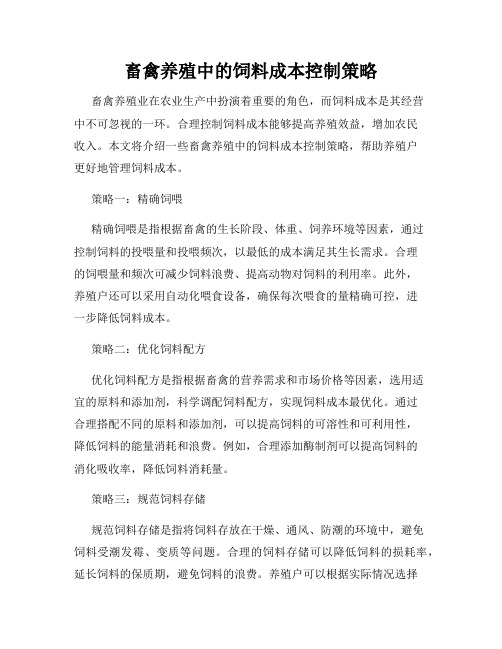
畜禽养殖中的饲料成本控制策略畜禽养殖业在农业生产中扮演着重要的角色,而饲料成本是其经营中不可忽视的一环。
合理控制饲料成本能够提高养殖效益,增加农民收入。
本文将介绍一些畜禽养殖中的饲料成本控制策略,帮助养殖户更好地管理饲料成本。
策略一:精确饲喂精确饲喂是指根据畜禽的生长阶段、体重、饲养环境等因素,通过控制饲料的投喂量和投喂频次,以最低的成本满足其生长需求。
合理的饲喂量和频次可减少饲料浪费、提高动物对饲料的利用率。
此外,养殖户还可以采用自动化喂食设备,确保每次喂食的量精确可控,进一步降低饲料成本。
策略二:优化饲料配方优化饲料配方是指根据畜禽的营养需求和市场价格等因素,选用适宜的原料和添加剂,科学调配饲料配方,实现饲料成本最优化。
通过合理搭配不同的原料和添加剂,可以提高饲料的可溶性和可利用性,降低饲料的能量消耗和浪费。
例如,合理添加酶制剂可以提高饲料的消化吸收率,降低饲料消耗量。
策略三:规范饲料存储规范饲料存储是指将饲料存放在干燥、通风、防潮的环境中,避免饲料受潮发霉、变质等问题。
合理的饲料存储可以降低饲料的损耗率,延长饲料的保质期,避免饲料的浪费。
养殖户可以根据实际情况选择合适的存储设备,如仓库、储藏室、密封容器等,确保饲料质量不受损害。
策略四:利用替代饲料利用替代饲料是指在合理控制饲料成本的前提下,采用一些代用原料或替代品来降低饲料成本。
替代饲料可以是一些廉价的农副产品或副产品,如秸秆、麸皮、饼粕等。
通过合理配比和加工处理,可以将这些替代饲料转化为高效的饲料资源,降低养殖成本。
策略五:精细管理精细管理是指通过科学的养殖管理技术,从饲料投喂、饮水管理、疾病防控等方面提高养殖效益,降低饲料成本。
精细管理需要养殖户做好记录、观察和评估工作,及时调整饲喂策略,应对不同生长阶段的需求变化。
通过精心管理,减少厌氧发酵、排泄物污染等现象,提高饲料利用率,节约饲料成本。
总结:畜禽养殖中的饲料成本是一个重要的经营成本,养殖户需要采取一系列的措施来控制饲料成本,提高养殖效益。
奶牛场成本分析与管控

奶牛场成本分析与管控李爱琴彭传文王铂(天津嘉立荷牧业集团有限公司天津300402)牧场运营的最终目的是获利,但是我们不能决定源头和终端产品价格。
只能通过更好的管理去追求最佳成本,追求最大产奶量,从最优成本到利润最大化。
一奶牛养殖成本分析我们通过强化牧场管理和完善绩效考核,找到牧场盈亏平衡点,达到牧场利润最大化。
二完善绩效考核我们集团设立考核机构———检查、监督,绩效图1犊牛场控饲养成本图2育成牛场控饲养成本图3公斤奶场控成本图4牧场盈亏关键———牛奶产量与投入成本平衡点考核分为3级。
1牧场一级绩效考核(确定牧场工资总额)1.1指标的确定年底时畜牧公司反复研究下属各分牧场当年各月报表情况,通过对市场、政策、成本、竞争单位、前几年生产情况等多方面比较分析后,制定牧场本年度的战略目标,包括产量、淘汰指标、繁殖指标、牛奶饲料场控成本、头均场控利润等量化指标,并将这些目标分解到下一年度的各月份。
1.2考核标准的确定确定牧场各量化指标后,进而确定各项指标的上下浮动考核标准。
考核奖励和处罚可以设定考核上、下限。
2部门二级绩效考核(确定部门工资总额)各部门根据牧场一级绩效考核方案,制定部门二级绩效考核方案,制定方案时要将一级绩效指标与部门工作内容相衔接,总体原则为通过各部门二级绩效指标的完成可以实现牧场一级绩效目标。
3个人三级绩效考核(确定个人工资)个人三级绩效考核的设定是将部门的绩效指标分解到个人的过程。
各部门负责人依据每个岗位的工作内容为部门每一位员工制定百分考核表。
牧场制定TMR、繁殖、兽医、资料管理员考核激励机制,鼓励员工竞赛进班组,比学赶帮超。
三强化管理1管理目标可视化1.1管理目标看版化图片左侧是我们嘉立荷所有牧场的分布图,右侧是每个月的管理目标制定,月底将完成情况填进去,绿色标注的是已经完成目标的牧场,红色标注的是未完成的牧场,数据的可视化公布,可以让场长清楚的知道自己的定位,能够更好的努力。
1.2生产指标看版化表1牧场一级绩效考核注:权重指占员工绩效工资的占比;考核指对绩效工资部分的考核例:成母牛月繁殖率一级绩效收入=绩效额度×10%+[(实际成母牛月繁殖率-计划成母牛月繁殖率)÷0.1]×绩效额度×10%×10%表2部门二级绩效考核图5考核重点内容图6集团大厅公示墙图7生产指标公示板牧场生产指标,比如体细胞,微生物,单产,乳指标等数据,每天都要作好记录,制作成看板公示出来,尤其是曲线图可以展示的更加明了,让员工都能清楚的知道。
养牛场成本管控方案

养牛场成本管控方案背景随着社会的发展,人们对肉制品的需求量逐渐增加,而养牛场作为肉制品的重要生产基地,其管理模式也日益重要。
在养殖业中,成本占比很高,成本控制就显得尤为重要。
因此,建立科学的成本管控方案,有利于提高养牛场的经济效益。
成本的分类养牛场的成本主要由以下几个方面组成:1. 饲料成本养殖业的成本构成中最为突出的就是饲料成本。
饲料是生长繁殖的必须品,直接影响着动物的生长和健康。
饲料的种类和质量会直接决定饲料成本的高低。
2. 劳动力成本养牛场的劳动力成本主要由人工费、社会保险费、福利费等构成。
提高员工效率、合理安排工作、减少人工损失等,都可以降低劳动力成本。
3. 土地租赁与维护费用在农业生产环节中,土地资源是必不可少的,而养牛场同样需要耕地。
土地租赁和维护的成本主要包括土地承租费用、土地整治费用等。
对于篇幅有限的本文档,这里不进行详细分析。
4. 设备和工具维护费用设备和工具的购置和维护对于养牛场经营来说尤为重要。
对设备和工具进行经常性维护,及时修理磨损或失效的部分,可以减少损坏和更换的成本。
成本管控方案1. 饲料采购对于饲料成本的控制,可以通过正确选择饲料、降低过度喂养、加强粗饲料饲养等方式来达到目的。
比如选择有优惠的饲料供应商或者自己种植一些便宜且富有营养价值的草料。
2. 劳动力和设备维护为了降低养牛场的劳动力成本,可以通过改善管理方式,提高员工的工作效率。
此外,定期维护和保养设备,及时修复损坏的部件等,以延长设备使用寿命,从而减少设备更换的成本。
3. 精心管理精心管理是养殖业成本控制的关键。
对于养牛场而言,合理控制饲养密度,防止疾病爆发,加强环境卫生等都可以保存养殖规模。
此外,为了提高养牛场的管理水平,可以引入新的管理技术,实现更加便捷高效的管理。
结论建立科学的成本管控方案,对于养牛场经济效益的提高具有举足轻重的作用。
不仅能够节省成本,加强竞争优势,还能够为行业的健康发展做出贡献。
控制牧场成本的措施

控制牧场成本的措施引言牧场经营是一个复杂的过程,其中成本控制是保持运营盈利的关键因素。
在现代社会,随着资源的稀缺和环境的变化,控制牧场成本不仅是一种经济需要,也是一种环境保护的要求。
本文将介绍一些控制牧场成本的有效措施,以帮助牧场主降低成本、提高经营效益。
1. 精细化管理精细化管理是控制牧场成本的核心措施之一。
通过精细化管理,可以对牲畜的饲养、疫病防控、资源利用等方面进行精确的监控和调控,从而提高生产效率,降低成本。
1.1 饲料管理合理的饲料管理是降低牧场成本的重要环节。
首先,牧场主可以根据牲畜的需求制定合理的饲料配方,避免过度或不足的饲养。
其次,可以通过精确的饲料供应和饲养管理,确保饲料的充分利用,避免浪费。
最后,及时清理、消毒饲喂设备,降低疾病传播的风险,减少兽医费用。
1.2 劳动力管理合理的劳动力管理可以提高工作效率,降低人力成本。
牧场主可以采取以下措施:•制定科学的工作计划和时间安排,避免工作冗余和重复;•培训和提升员工的工作技能,减少失误和浪费;•合理配置工作任务,充分发挥每个员工的优势;•使用智能化设备和技术,提高工作效率。
1.3 疫病防控管理疫病是牧场成本的重要来源之一。
牧场主可以采取以下措施有效地进行疫病防控:•定期接种疫苗,提高牲畜的免疫力;•定期检查牲畜的健康状况,及时发现和隔离病例;•保持良好的卫生环境,定期消毒和清理牲畜舍、饲养设备等;•加强与兽医和动物卫生局的合作,获取及时的疫情信息和技术支持。
2. 资源节约与利用资源的节约和利用是降低牧场成本的另一个重要方面。
以下是一些有效的资源节约和利用措施:2.1 水资源管理合理的水资源管理可以降低相关的成本开支。
牧场主可以采取以下措施:•建立水资源监测系统,实时监控水的流量和质量;•优化灌溉系统,减少用水量,并提高灌溉效果;•收集和利用雨水,减少对市政水源的依赖;•加强水资源的维护和保护。
2.2 草场管理草场是牧场的重要资源之一,合理的草场管理可以提高资源的利用效率。
养牛技术:降低奶牛饲料成本的途径

许多因素导致当前的饲料价格创记录的高,其中有一些情形是供应减少。
尽管人们都在探讨新的管理策略,但我们在过去的经验也能为现在或将来的一些选择提供指导。
我们最常遇到的一个问题是:我们的日粮用什么原料能降低成本?这里有一些选择。
但是,这些原料的添加比例,有时候也有供应情况,限制了我们的选择。
比如,当玉米的价格是276美元/吨,豆粕的价格是432美元/吨、石粉的价格是296美元/吨、磷酸氢钙的价格是758美元/吨时,甜菜渣、玉米蛋白粉、酒糟、玉米纤维、麦芽渣、大豆皮和乳清粉可能都是很好的选择。
但是,玉米蛋白粉和大豆皮有时候供应就很紧张。
菜籽粕也是一个很有竞争力的选择,但供应也不稳定。
另一个问题是优质的粗饲料。
可能很难找到能替代粗饲料的原料并有价格优势,那我们能做什么呢?你和你的营养师就要时刻注意快速变化的日粮成本,可以买到的饲料原料和你的库存情况。
如果说历史上有时候能实时评价库存情况和购买计划,现在就是这个时候。
以下是一些可以考虑的管理选择:•不要使用表格或书本上的饲料原料的营养组成;请取样送检。
•饲料原料营养分析的误差常常是由于现场的取样技术不对和取样频率不够。
•青贮窖内不同位置粗饲料质量的差异(苜蓿青贮和玉米青贮也有不同)、以及所取样品相对的均质性和取料面剔除的饲料等都将导致所测试的样品与实际情况之间有一定的差异。
•在样品结果出来之前启用新的青贮袋或配制一种新的日粮,都能导致奶牛所采食的养分有很大的变化。
•饲喂颗粒大小相当的粗饲料,减少挑食。
•经常检测湿的饲料原料的干物质浓度,并相应调整日粮以维持日粮成分干物质比例的稳定和准确。
•减少与饲料混合和投送过程中有关人员操作的误差。
尽最大可能保证日粮批次之间的稳定性。
•饲喂部分的全混日粮,或在混合日粮之外添加一定比例的粗饲料或精饲料,是牛群内奶牛之间养分摄入的一大差异来源。
•奶牛在料槽内不能拥挤。
新产牛、临产牛不能拥挤。
•提前预定饲料总能够省钱。
•仔细考虑饲料添加剂的问题。
农户养牛如何降低饲料成本?

农户养牛如何降低饲料成本?
农民挣钱不容易,投资越大风险越大,在养牛设备,或者养牛建设中能省则省,今天大汉养殖场专家教你们如何在养牛饲料中降低养牛成本?
{1}养牛人员要随时保持舍内卫生,尽量用废弃的杂草做牛的垫草,以减少饲草浪费。
{2}少喂勤添,可节省饲草.一次喂给,肉牛易养成挑剔适口草料的毛病。
{3}养牛人员在喂肉牛的时候,要先喂粗饲料,肉牛会饥不择食,采食粗饲料较多。
之后,在按其营养需要饲喂精料,或者牧草。
这样,充分发挥了反刍牛对粗饲料的利用特点,节省了饲草。
{4}养牛人员若能用饲草的农作物秸秆进行盐化、碱化、氨化处理,或粉碎后拌精料喂肉牛,能提高饲草的利用率,增加适口性,从而节省了饲草。
{5}养牛人员要改变把饲草直接扔在牛栏里饲喂的不良习惯,应将饲草放在槽内饲喂肉牛,这样饲草就不会饲草就不会被粪便污染,肉牛食后卫生,免生疾病,也节省了大量的饲草。
{6}如果肉牛吃剩下的粗硬茎秆养牛人员不要烧掉,大汉养殖场建议可以再次利用,将其晾干后收集起来,用粉碎机碎成草粉,然后再喂,这样就能得到有效的利用。
{7}常因食槽过浅,使肉牛在吃草时把草料弄到外面,造成了不少浪费。
在制作食槽时,只要做的深一些,即可避免。
一般肉牛槽深度在40厘米左右为好。
咋降低奶牛饲养成本

安装温控设备和通风系统,根据需要调节牛舍温度。同时,确保设 备正常运行,避免损坏或故障。
观察奶牛反应
密切观察奶牛对温度的反应,及时调整温度设置。如果奶牛出现颤抖 、食欲不振等异常行为,可能意味着温度不适宜。
保持牛舍清洁卫生
定期清理牛舍
定期清理牛舍,保持干燥和通风。清理牛粪和饲料残渣,减少细 菌滋生。
定期检查供水系统, 确保水资源的合理利 用。
节能减排措施
采用节能设备,如LED灯、节能 型饲料加工设备等。
合理规划电力线路,减少电力损 耗。
实施绿色能源计划,利用太阳能 、风能等可再生能源。
利用可再生能源
利用太阳能
安装太阳能热水器,提供热水和 照明。
利用风能
安装风力发电设备,提供电力。
利用生物质能
定期检查牛只健康状况
定期检查
定期对奶牛进行健康检查,包括体温、呼吸、食量、排泄等方面,及时发现并处 理异常情况。
疾病预防
制定科学的疾病预防计划,定期给奶牛接种疫苗,避免或减少疾病的发生。
03
水电费用
合理安排用水计划
根据奶牛饲养需求, 合理规划用水计划, 避免浪费。
在保证奶牛健康的前 提下,尽量减少用水 量。
定期检查设施
定期检查牛舍设施,包括饮水设施、饲料设施等,以保证其正常 运转。
定期清洁
定期清洁牛舍,保持卫生环境,减少疾病的发生。
定期维修
定期维修牛舍设施,及时更换损坏的设备,保证正常运转。
06
环境控制
控制牛舍温度
适宜的温度范围
奶牛在不同生长阶段对温度有不同的需求。保持适宜的温度范围有 助于提高奶牛的舒适度和生产性能。
矿物质和维生素
科学养殖调整饲料成本的措施

科学养殖调整饲料成本的措施随着养殖业的发展,饲料成本一直是养殖户们关注的重点之一。
饲料成本占据了养殖成本的很大一部分,因此如何降低饲料成本,提高养殖效益成为了养殖户们亟需解决的问题。
科学养殖调整饲料成本的措施是解决这一问题的有效途径之一。
本文将从饲料种类选择、饲料搭配、饲料加工技术、饲料管理等方面进行探讨,希望能够为养殖户们提供一些有益的参考。
一、饲料种类选择。
首先,科学养殖调整饲料成本的措施之一是选择适合的饲料种类。
不同的养殖动物对饲料的需求是不同的,因此在选择饲料种类时需要根据养殖动物的需求来进行选择。
一般来说,饲料种类可以分为粗饲料和浓饲料两大类。
粗饲料主要包括青草、饲料秸秆等,适合于反刍动物的饲养;浓饲料主要包括玉米、豆粕、鱼粉等,适合于禽畜的饲养。
在选择饲料种类时,需要根据养殖动物的种类和生长阶段来进行选择,以满足养殖动物的生长需求,降低饲料成本。
二、饲料搭配。
其次,科学养殖调整饲料成本的措施之一是合理搭配饲料。
饲料搭配是指将不同种类的饲料按照一定的比例混合在一起,以满足养殖动物的生长需求。
合理的饲料搭配可以提高饲料的利用率,降低饲料成本。
一般来说,饲料搭配需要根据养殖动物的种类、生长阶段和生长需求来进行选择,以保证养殖动物获得充分的营养,提高养殖效益。
三、饲料加工技术。
此外,科学养殖调整饲料成本的措施之一是采用先进的饲料加工技术。
饲料加工技术可以提高饲料的利用率,降低饲料成本。
一般来说,饲料加工技术可以分为粉碎、混合、造粒等几个环节。
通过粉碎可以将饲料原料打碎成适合养殖动物食用的颗粒;通过混合可以将不同种类的饲料按照一定的比例混合在一起;通过造粒可以将混合好的饲料压制成适合养殖动物食用的颗粒。
采用先进的饲料加工技术可以提高饲料的利用率,降低饲料成本。
四、饲料管理。
最后,科学养殖调整饲料成本的措施之一是加强饲料管理。
饲料管理是指根据养殖动物的需求,合理地投喂饲料,以保证养殖动物获得充分的营养,提高养殖效益。
控制饲料成本的五种方法
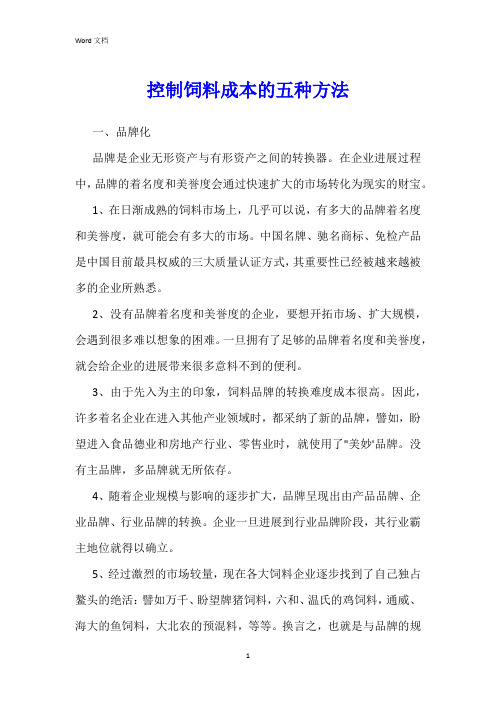
控制饲料成本的五种方法一、品牌化品牌是企业无形资产与有形资产之间的转换器。
在企业进展过程中,品牌的着名度和美誉度会通过快速扩大的市场转化为现实的财宝。
1、在日渐成熟的饲料市场上,几乎可以说,有多大的品牌着名度和美誉度,就可能会有多大的市场。
中国名牌、驰名商标、免检产品是中国目前最具权威的三大质量认证方式,其重要性已经被越来越被多的企业所熟悉。
2、没有品牌着名度和美誉度的企业,要想开拓市场、扩大规模,会遇到很多难以想象的困难。
一旦拥有了足够的品牌着名度和美誉度,就会给企业的进展带来很多意料不到的便利。
3、由于先入为主的印象,饲料品牌的转换难度成本很高。
因此,许多着名企业在进入其他产业领域时,都采纳了新的品牌,譬如,盼望进入食品德业和房地产行业、零售业时,就使用了"美妙'品牌。
没有主品牌,多品牌就无所依存。
4、随着企业规模与影响的逐步扩大,品牌呈现出由产品品牌、企业品牌、行业品牌的转换。
企业一旦进展到行业品牌阶段,其行业霸主地位就得以确立。
5、经过激烈的市场较量,现在各大饲料企业逐步找到了自己独占鳌头的绝活:譬如万千、盼望牌猪饲料,六和、温氏的鸡饲料,通威、海大的鱼饲料,大北农的预混料,等等。
换言之,也就是与品牌的规模化相伴而生,品牌的专业化倾向也愈来愈明显。
二、规模化大企业越来越大,成为饲料行业进展的新趋势,而大企业扩张的方式也正在发生重大变化。
1、兼并重组:新盼望兼并六合,六和兼并石羊,成为2021年、2021年饲料行业进展的两大新闻。
这也意味着饲料行业,尤其是大型饲料企业的进展,已经由传统的征地建厂型向兼并重组型转变。
2、资本运作:正虹、新盼望、通威等饲料企业渐次上市,成为饲料企业资本运作的典范;广东海大以技术、人才、市场为突出优势,汲取外来资本,又成为另一种资本经营的模式。
三、产业化向饲料工业的上下游延长,在产业链上做文章已经成为一种趋势,其中有"一条龙+农户'、"公司+农户'、"公司+基地+农户'、"公司+农户+市场'等多种形式,最突出的是六和、温氏、正大的鸡产业链,通威、海大的鱼产业链,盼望、唐人神的猪产业链,恒兴的虾产业链,等等。
饲料厂成本管理制度
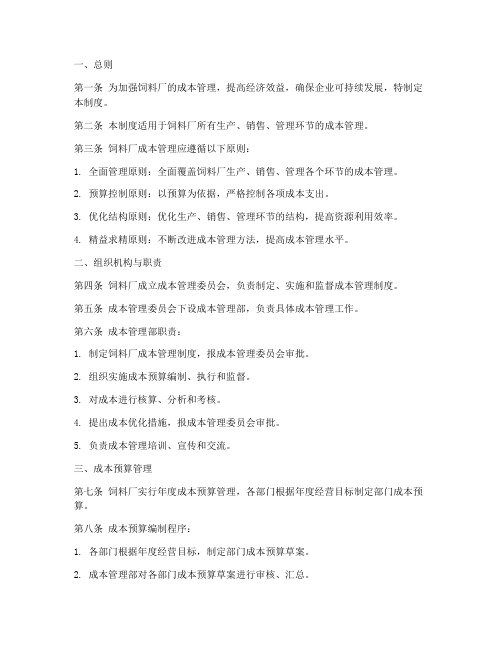
一、总则第一条为加强饲料厂的成本管理,提高经济效益,确保企业可持续发展,特制定本制度。
第二条本制度适用于饲料厂所有生产、销售、管理环节的成本管理。
第三条饲料厂成本管理应遵循以下原则:1. 全面管理原则:全面覆盖饲料厂生产、销售、管理各个环节的成本管理。
2. 预算控制原则:以预算为依据,严格控制各项成本支出。
3. 优化结构原则:优化生产、销售、管理环节的结构,提高资源利用效率。
4. 精益求精原则:不断改进成本管理方法,提高成本管理水平。
二、组织机构与职责第四条饲料厂成立成本管理委员会,负责制定、实施和监督成本管理制度。
第五条成本管理委员会下设成本管理部,负责具体成本管理工作。
第六条成本管理部职责:1. 制定饲料厂成本管理制度,报成本管理委员会审批。
2. 组织实施成本预算编制、执行和监督。
3. 对成本进行核算、分析和考核。
4. 提出成本优化措施,报成本管理委员会审批。
5. 负责成本管理培训、宣传和交流。
三、成本预算管理第七条饲料厂实行年度成本预算管理,各部门根据年度经营目标制定部门成本预算。
第八条成本预算编制程序:1. 各部门根据年度经营目标,制定部门成本预算草案。
2. 成本管理部对各部门成本预算草案进行审核、汇总。
3. 成本管理委员会审批年度成本预算。
4. 各部门执行年度成本预算。
第九条成本预算执行与监督:1. 各部门应严格执行年度成本预算,不得擅自调整预算。
2. 成本管理部定期对各部门成本预算执行情况进行检查、分析。
3. 对预算执行过程中发现的问题,及时上报成本管理委员会。
四、成本核算与分析第十条饲料厂实行成本核算制度,各部门按月、季度、年度进行成本核算。
第十一条成本核算内容:1. 生产成本核算:包括原材料、人工、制造费用等。
2. 销售成本核算:包括销售费用、管理费用等。
3. 财务成本核算:包括利息、汇兑损益等。
第十二条成本分析:1. 成本管理部定期对成本核算结果进行分析,找出成本高企的原因。
2. 分析成本变化趋势,预测未来成本变动。
降低奶牛养殖成本五建议

成 年奶 牛 的产奶 量通 常在 第6 以后 逐 胎 渐 下 降 , 供生 产 年 限 在 1 年 以 内, 每 年 可 O 即 的正常 淘汰 率应 1 % 右 : 0左 此外 , 群 中有 5 牛 % 1% 0 的低 产 牛 , 及 时 淘汰 。 以 , 场 奶 需 所 牛 牛 群 的淘汰 率一 般控 制在 1% 0 后 备 母 5  ̄2 %,
地 天 气预 报 , 时 了解 冷空 气 信 息 , 有针 及 并 对 性地 做好 预防 工作 。 2 预 防 蛋鸡 减 产 。 冷 空 气 到来 之 前 2 . 在
业遭 受意想 不 到的损 失 , 殖 户对 此 必须 高 养 度重 视 , 意 防范 。 注 冷 空气 对养殖 业生 产 据报 道 , 空 冷 气对 蛋鸡 影响 甚大 , 其危 害程度 因冷 空气 的
为 6 g 4 g k : 汁料 : 般 用 于产 奶 的 k , k 和2 g 多 一 母 牛 , 用 时期 通 常 按半 年 计 算 , 使 日需量 为
2 g。 0k
三、 力促 高产 奶 牛产前 3 天 到产 后 7 天 的饲 养 , O 0 是决 定 奶牛 高产性 能 能否充 分 发挥 的关 键时 期 , 其主 要技 术有 5 : 点 1 满足 干 物 质 采食 量 。 前 1 月食 入 . 产 个
影响奶 牛养 殖成 本 的因 素 多种 多样 , 并 涉 及 到方 方 面 面 。 整 体 而 言 , 从 目前饲 料 成 本偏 高 , 重制 约 了奶 牛 业 的发 展 。 何 降 严 如 低 饲料 成本 , 从科 学技 术 角度 考虑 , 5 建 有 条
议 , 供参 考 : 可
的干 物质 重量 应达 到体 重 的2 , % 产前 半个 月 达2 5 , 后7 天达 4 。 .%产 0 % 为此 , 提倡 使用 优 宜 质干草 ; 减少 日粮 的含水 量 ( 不超 过5 % ; 、 o)粗 精干 物质 比最 好 为4 : 5 5 :0 日粮 的粗 5 5或 05 : 纤维 含量 不低 于 1% 且含 有 1 3 长纤维 。 5, /的 2 供给 适 量的蛋 白质 。 . 日粮 的粗 蛋 白水 平在产前 1 月为 1. %产 前半个月为1 . % 个 35, 45 , 产后 1 月 内为 l % 泌乳 高 峰为 1 % 泌乳 中 个 9, 7, 后期 为1% 日粮 可消化蛋 白质是粗 蛋 白质 的 5o 6 % 5 , 高产 者 应 添 加过 瘤 胃 蛋 白 , 0  ̄6 % 对 也 可添 加 赖 氨 酸 、 蛋氨 酸 等 。 日产 3 k 标 准 乳 4g 的奶牛 可加入0 5 g . k 的动物 蛋 白质 ( 如鱼粉) 。 3 饲 料 营 养 均衡 。 . 日粮 中的 钙 、 含 量 磷 应 高于 标 准2 % 5 维 生素 A 维 生 素D 维 0 和 %。 、 、 生素E 烟 酸) 微量 元素 可按 标准 使用 复 合 ( 和
牧场降本增效措施
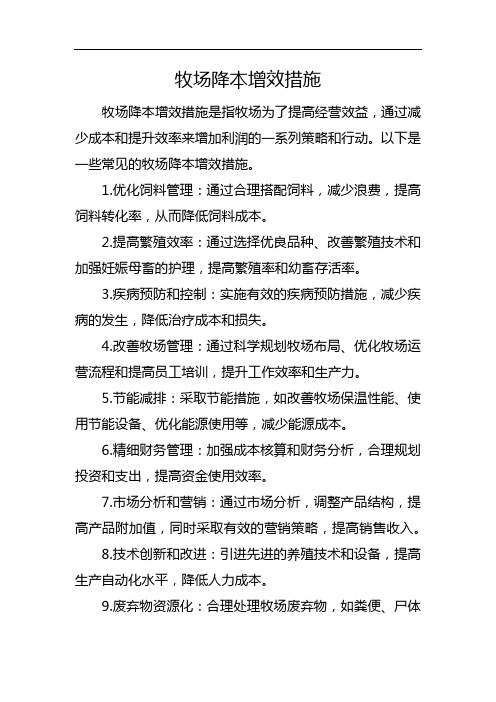
牧场降本增效措施
牧场降本增效措施是指牧场为了提高经营效益,通过减少成本和提升效率来增加利润的一系列策略和行动。
以下是一些常见的牧场降本增效措施。
1.优化饲料管理:通过合理搭配饲料,减少浪费,提高饲料转化率,从而降低饲料成本。
2.提高繁殖效率:通过选择优良品种、改善繁殖技术和加强妊娠母畜的护理,提高繁殖率和幼畜存活率。
3.疾病预防和控制:实施有效的疾病预防措施,减少疾病的发生,降低治疗成本和损失。
4.改善牧场管理:通过科学规划牧场布局、优化牧场运营流程和提高员工培训,提升工作效率和生产力。
5.节能减排:采取节能措施,如改善牧场保温性能、使用节能设备、优化能源使用等,减少能源成本。
6.精细财务管理:加强成本核算和财务分析,合理规划投资和支出,提高资金使用效率。
7.市场分析和营销:通过市场分析,调整产品结构,提高产品附加值,同时采取有效的营销策略,提高销售收入。
8.技术创新和改进:引进先进的养殖技术和设备,提高生产自动化水平,降低人力成本。
9.废弃物资源化:合理处理牧场废弃物,如粪便、尸体
等,实现资源化利用,减少环境污染和成本。
10.政策支持和合作:积极争取政府政策支持,参与国际合作和交流,引进外部资源和技术,提升牧场竞争力。
牧场降本增效措施需要根据具体的牧场条件和市场需求来制定和实施,通过持续改进和创新,实现牧场的可持续发展。
养牛成本预算方案

养牛成本预算方案1. 引言养牛是一项常见的农业生产活动,其成本预算方案的制定对于牧场经营者来说至关重要。
本文将介绍一种养牛成本预算方案,以帮助牧场经营者合理规划和控制成本,实现经济效益最大化。
2. 养牛成本要素在制定养牛成本预算方案之前,我们首先需要了解养牛的各项成本要素。
养牛的主要成本要素包括以下几个方面:•饲料成本:养牛需要提供饲料来满足其生长发育的需求,饲料成本是养牛成本的主要组成部分。
•劳动力成本:养牛需要人工来进行日常管理、喂养、清洁等工作,劳动力成本是养牛成本的重要组成部分。
•兽医费用:养牛可能会出现疾病和健康问题,兽医费用用于预防和治疗疾病,保证牛群健康。
•设备与修缮成本:养牛对于场地、栏舍、设备等方面有一定的要求,这些设备的购买和维修成本需要考虑在内。
3. 具体成本预算方案基于以上成本要素,我们可以制定如下的养牛成本预算方案:3.1 饲料成本预算饲料成本是养牛成本的主要部分,我们可以按照以下步骤制定饲料成本预算:1.根据养牛的品种和规模确定日常饲料需求量。
2.调查周边市场的饲料价格,并选择性价比较高的供应商。
3.根据饲料价格和饲料需求量计算每月的饲料成本。
3.2 劳动力成本预算劳动力成本也是养牛成本中的重要部分,我们可以按照以下步骤制定劳动力成本预算:1.根据牛群规模确定需要的劳动力数量。
2.调查当地劳动力市场,了解工资水平。
3.根据劳动力数量和工资水平计算每月的劳动力成本。
3.3 兽医费用预算兽医费用用于保障牛群的健康,我们可以按照以下步骤制定兽医费用预算:1.与当地兽医合作,了解兽医服务价格。
2.根据牛群规模和历史疾病发生率,估计每月的兽医费用。
3.4 设备与修缮成本预算养牛需要一定的设备和场地支持,我们可以按照以下步骤制定设备与修缮成本预算:1.根据牛群规模和需要的设备列表,调查设备价格。
2.评估栏舍和场地的现状,估计修缮和改造的成本。
3.计算设备和修缮成本的折旧和维护费用。
奶牛场生产成本控制

奶牛场生产成本控制成本控制现代业管理中占有重要地位,对奶牛场来说也不例外,只有通过措施得当的成本控制方法,才能保证奶牛场生产的正常运营,并取得预期的经济效益据调查发现,相当数量的中小型奶牛场的成本控制还停留在场主的“一支笔”上,当然就谈不上建立科学完整的成本管理机制。
更有甚者,只重视牛奶的产量以及价格,却轻视了生产成本控制环节。
其实在市场经济环境下,价格是外在的、可控性较小的因素,而生产成本则是奶牛场内部的事,是可控的,只是其控制程度因牛场的具体情况而有所区别:笔者通过参与5家奶牛场的生产实践,调查分析了奶牛场生产成本的构成,并有针对性地提出了奶牛场生产成本控制策略。
1 奶牛场生产成本的定义与构成1.1 生产成本定义奶牛场的生产成本从广义上讲是指所有与原料奶生产及其相关活动所需的费用总和。
就奶牛场而言,生产成本主要由直接生产成本和间接生产成本两部分构成:1.2 生产成本的构成奶牛场生产成本由直接成本和问接成本构成,其中,直接成本主要包括饲料费、劳务费、折旧费、疫病防疫费、其他费用;间接成本包括共同生产费和企业管理费=鉴于奶牛场一天中生产成本开支最大的就是饲料费用,故在此只重点介绍奶牛场直接生产成本的构成:直接生产成本包括饲料费(青饲料费、精饲料费等)、劳务费(工资、福利费)、折旧费(固定资产折旧费、成母牛折旧费)、疫病防疫费(兽药费、消毒剂及治疗费、检疫费、配种费)、其他费用(低值易耗1.3 成本分布状况成本构成一旦明确,必须分析各项目所占份额和迁移状况,有针对性地采取强劲对策。
伴随牛群结构的变化,成本分布在不断变移某奶牛场年生产成本的分布状况如图l所示,同时该图也描述了生产成本各主要影响因素的排序状况。
2 影响奶牛场生产成本主要因素分析奶牛专栏母牛折旧,该牛场圈舍设备按25年折旧,预计残值按原值的5%计算。
成年母牛按8年折旧,预计残值按原值的10%计算。
近年来,随着奶牛养殖业的不断发展,饲草料基地建设显得较为薄弱,没有固定的饲草料基地,就连一些规模化奶牛场大多都采用订单形式收购饲草料。
牛奶牧场成本控制措施
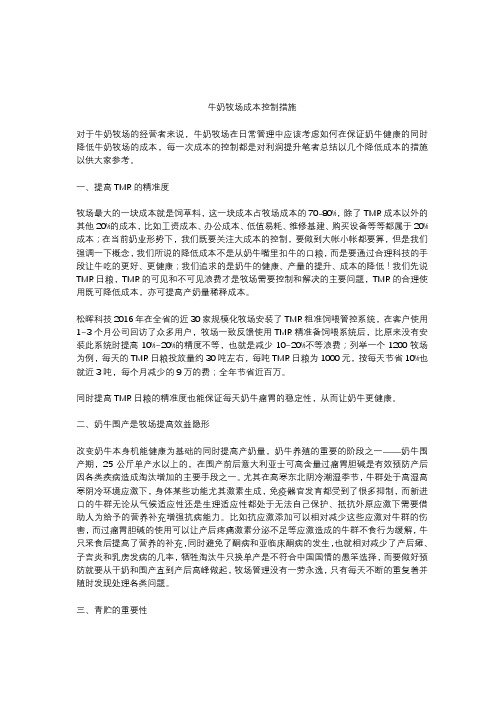
牛奶牧场成本控制措施对于牛奶牧场的经营者来说,牛奶牧场在日常管理中应该考虑如何在保证奶牛健康的同时降低牛奶牧场的成本,每一次成本的控制都是对利润提升笔者总结以几个降低成本的措施以供大家参考。
一、提高TMR的精准度牧场最大的一块成本就是饲草料,这一块成本占牧场成本的70-80%,除了TMR成本以外的其他20%的成本,比如工资成本、办公成本、低值易耗、维修基建、购买设备等等都属于20%成本;在当前奶业形势下,我们既要关注大成本的控制,要做到大帐小帐都要算,但是我们强调一下概念,我们所说的降低成本不是从奶牛嘴里扣牛的口粮,而是要通过合理科技的手段让牛吃的更好、更健康;我们追求的是奶牛的健康、产量的提升、成本的降低!我们先说TMR日粮,TMR的可见和不可见浪费才是牧场需要控制和解决的主要问题,TMR的合理使用既可降低成本,亦可提高产奶量稀释成本。
松晖科技2016年在全省的近30家规模化牧场安装了TMR粗准饲喂管控系统,在客户使用1~3个月公司回访了众多用户,牧场一致反馈使用TMR精准备饲喂系统后,比原来没有安装此系统时提高10%~20%的精度不等,也就是减少10~20%不等浪费;列举一个1200牧场为例,每天的TMR日粮投放量约30吨左右,每吨TMR日粮为1000元,按每天节省10%也就近3吨,每个月减少的9万的费;全年节省近百万。
同时提高TMR日粮的精准度也能保证每天奶牛瘤胃的稳定性,从而让奶牛更健康。
二、奶牛围产是牧场提高效益隐形改变奶牛本身机能健康为基础的同时提高产奶量,奶牛养殖的重要的阶段之一——奶牛围产期,25公斤单产水以上的,在围产前后意大利亚士可高含量过瘤胃胆碱是有效预防产后因各类疾病造成淘汰增加的主要手段之一。
尤其在高寒东北阴冷潮湿季节,牛群处于高湿高寒阴冷环境应激下,身体某些功能尤其激素生成,免疫器官发育都受到了很多抑制,而新进口的牛群无论从气候适应性还是生理适应性都处于无法自己保护、抵抗外原应激下需要借助人为给予的营养补充增强抗病能力。
如何降低奶牛养殖的饲料成本
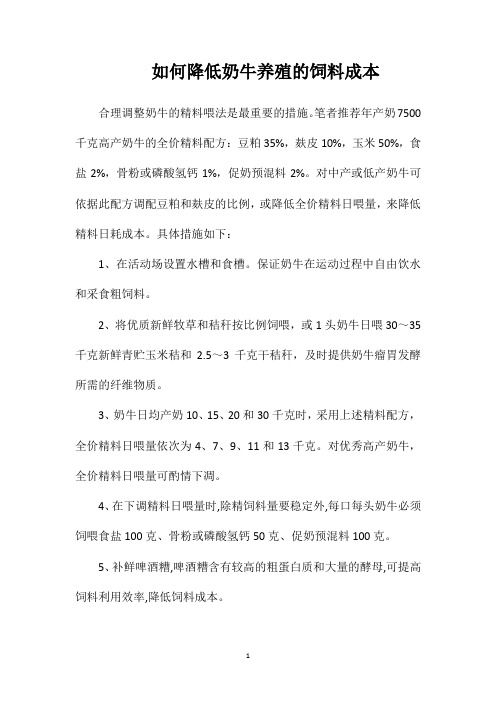
如何降低奶牛养殖的饲料成本合理调整奶牛的精料喂法是最重要的措施。
笔者推荐年产奶7500千克高产奶牛的全价精料配方:豆粕35%,麸皮10%,玉米50%,食盐2%,骨粉或磷酸氢钙1%,促奶预混料2%。
对中产或低产奶牛可依据此配方调配豆粕和麸皮的比例,或降低全价精料日喂量,来降低精料日耗成本。
具体措施如下:
1、在活动场设置水槽和食槽。
保证奶牛在运动过程中自由饮水和采食粗饲料。
2、将优质新鲜牧草和秸秆按比例饲喂,或1头奶牛日喂30~35千克新鲜青贮玉米秸和2.5~3千克干秸秆,及时提供奶牛瘤胃发酵所需的纤维物质。
3、奶牛日均产奶10、15、20和30千克时,采用上述精料配方,全价精料日喂量依次为
4、7、9、11和13千克。
对优秀高产奶牛,全价精料日喂量可酌情下凋。
4、在下调精料日喂量时,除精饲料量要稳定外,每口每头奶牛必须饲喂食盐100克、骨粉或磷酸氢钙50克、促奶预混料100克。
5、补鲜啤酒糟,啤酒糟含有较高的粗蛋白质和大量的酵母,可提高饲料利用效率,降低饲料成本。
如何降低奶牛养殖的饲料成本。
- 1、下载文档前请自行甄别文档内容的完整性,平台不提供额外的编辑、内容补充、找答案等附加服务。
- 2、"仅部分预览"的文档,不可在线预览部分如存在完整性等问题,可反馈申请退款(可完整预览的文档不适用该条件!)。
- 3、如文档侵犯您的权益,请联系客服反馈,我们会尽快为您处理(人工客服工作时间:9:00-18:30)。
Five Steps to Controlling FeedCostsJ.D. KLEINSCHMIDT BS(Agr) MSC1. Know your costsTo gain an accurate picture of your costs, you should monitor feed use, cow numbers, and the milk cheque every month. These numbers will not only give you what you need to calculate feed costs, but you can also monitor feed inventories and plan your feed requirements for the next cropping season.Don’t be misled by methods of calculating feed costs. Spartan Dairy Ration Formulator (Michigan State University), for example, calculates dollars/100 kilograms of milk, based on cow description and kilograms of milk per day. This figure is only accurate for cows producing close to the quantity of milk described, and does not take into account maximised dry matter intakes.Don’t lie to yourself. Price all ingredients accurately, including your homegrown forages; update ingredient prices regularly. Remember, most feed ingredients are priced on the commodity market: when grain prices go up, by-product feeds such as distillers’ grains follow; if oilseed values go up, protein meals won’t be far behind.There are really no-good feed-costing guides out there. Many progressive producers track feed and production costs, but there is little consistency in their methods of calculation. This, along with differences in feed quality and input prices, make it very difficult to compare productivity and costs between farms.Some promising work is currently being done by the Canadian Farm Business Bureau, but our financial institutions and accountants should be showing much more leadership in this area.If you have trouble estimating your current feed costs, why not ask your banker or accountant for some help? They should have the skills to develop a comprehensive spreadsheet that you can maintain to come up with the final figures.Until you have a handle on what your feed costs of production really are, you have little hope of reducing them.2. Feed smart, not cheapGetting the most for your feed buck often involves fine-tuning herd management, not just seeking cheap feeds:Cull the losers. Of all the changes that should be made, culling unprofitable cows should be first on the list. Many producers keep loser cows around in the hope that they will do better. With high feed costs, keeping break-even cows around is a luxury nobody can afford.Remember the higher producing animals are the ones that save you money because the cost of nutrients for body maintenance per kilogram of milk goes down as production goes up.In simpler terms, it would pay you to feed a smaller herd of highproducers than a larger herd with several losers.Track the costs of your milk components. Unfortunately, the nutrients required to boost component production are not free; they must be fed to your cows.Milk protein is usually the most expensive component because of its highrequirement for absorbable protein, which is often “expensive protein”.Feeding fewer nutrients can be costly. Be sure that you know what it costs in lost milk before you make the choice to intentionally reduce the nutrient density in your herds’ ration. Often, the cost of lost production far exceeds any savings in feed.In addition, many cows, once they are “told” to slow down in milk production, will not pick up again during that lactation. This is a costly experiment.Feed additives are there for a reason. When feed costs rise, one of the first ingredients to get tossed are additives going into the ration, such asbuffers, yeast cultures, niacin, anionic salts, and chelates. A feed additive is in a ration because we have determined it has a beneficial effect onproduction, animal health or both. In addition, that additive must be offering us a cost return, be it in higher milk or milk components, better feedefficiency, or lower vet bills.With this in mind, can you afford to remove the additive? If all of the previous criteria have been met, the answer would obviously be “no”.There are other ways to reduce feed costs:-Split the herd into at least 2 milking groups, such that you are feeding less expensive rations without the bells and whistles to low producers and late-lactation cows, while challenging fresh and top cows with a hotter, moreexpensive ration.-Feed leftovers to the heifer groups, never to dry cows!-Ensure that there is feed and fresh water available to the cows 24 hours a day.-Clean the mangers daily.-Make sure that the farm’s “feeder” is extremely reliable and uses accurate scales.-Run dry matter tests on all wet ingredients once a week to ensure that you are not under-feeding or over-feeding.-Analyse all forages; feed a well-balanced ration.3. Start with forages and work upBottom line: your ability to reduce feed costs will be directly related to your ability produce and make the best use of excellent “dairy forage”.You can reduce the loss in production due to poor-quality forages by formulating rations with higher supplement levels, but it is unlikely that you will regain 100% of lost production because of the reduction in dry matter intake. The lower the quality of your forages, the longer it remains in the ruminant digestive tract, which in turn leads to depressed dry matter intake and a decrease in animal productivity. In addition, I can guarantee that your feed costs will be considerably higher.Forage quality is an important management tool. Those who produce and feed high-quality forages are rewarded with increased animal performance, reduced feed costs, and a rising return on the time and money they invest in this critical feed ingredient.It is not enough to grow quality forages; you must also preserve that quality by harvesting the plants at their optimum maturity, this is especially critical with alfalfa, to gain top productivity.Effect of Forage QualityOn Predicting Forage Dry MatterIntake of RuminantsForage QualityForageNDF (DM)DM Intake(% BW)Excellent 38 % 3.1640 % 3.0042 % 2.8644 % 2.7346 % 2.6148 % 2.5050 % 2.4052 % 2.31Poor 54 % 2.22Analysis of alfalfa at various stages of maturityPercent DMStage Protein ADF NDF RFV Bud >19 < 30 < 40 > 140 Early bloom 16 – 19 30 – 35 40 – 45 124 – 140 Mid-bloom 13 – 15 36 – 40 46 – 50 101 – 123 Full bloom < 13 > 40 > 50 < 100 Effect of stage of maturity on digestibility and intake of alfalfaStage % Digestible(kg/d) Intake (kg DM)Pre-bud 66.8 15.5Bud 65.0 15.1Early bloom 63.1 14.5Mid-bloom 61.3 13.9Full bloom 59.4 13.3Late bloom 57.5 12.6Mature 55.8 12.04. Look before you leap into commodity buyingInterest in commodity feeding was born primarily out of people’s desire to lower feed costs in large TMR herds. Commodity feeding has been touted to save between $25 and $30 per tonne over traditional complete feeds. However, I think a more realistic figure is closer to $8 per tonne.Some points to ponder before moving into the commodity game:A dairy producer considering commodity feeding must enjoy the game ofbuying commodities on the open market. If you do not have time to keep current on the market prices, or you don'’ like the uncertainty of forwardcontracts, then commodity feeding is not advisable.Commodity feeding involves a commitment in time to purchase ingredients, assess their quality, and mix them. Basically, you are replacing for feedcompany and all of the services they provide.Don’t buy a commodity simply because it’s cheap; it has to fit into your program in a cost-effective manner. Ask your nutritionist to run it through your program and see what opportunity, if any, it holds for you. A nutritionist?Yes! A dairy manager who is committed to commodity feeding will tend to move away from feeding cows to the business of purchasing commodities.This means that skilled nutritional advice becomes even more important, but your local feed company will probably be reluctant to spend nutritionist time on you because you are no longer purchasing through them.Also consider shelf life in relation to the quantities bought and the usage rate.High-moisture feeds like brewers’ grains can present challenges to smaller herds because of their perishability. Remember too, that vitamin losses in pre-mixes are at least 1% to 3% per month.Feed value can vary significantly from load to load; be prepared to perform regular feed analysis and adjust the rations before problems develop. Unless you are buying from a feed company or broker, there are no minimumguarantees on nutrients or assurance of quality. This is your responsibility now.Is the supply of a particular commodity feed dependable at a cost-effective price? If not, can you change your program quickly without damaging the cows (i.e. introducing fat)? Would a blend of feeds be more appropriate thana single source commodity?5. Tenders and contracts can get you the best dealsWith my clients, I tender out custom feeds designed specially for their forage base and herd conditions. It is strictly the decision of those clients which feed companies are involved; we usually invite tenders from about 3 companies.Basically, I fax the individual companies copies of the specifications of my program. I receive in return a dollar quote, a list of ingredients, and verified specs. It is always interesting to see which company is awarded the tender; it’s not always the cheapest quote.We usually settle on one company for the entire herd’s requirements. This allows for more aggressive pricing and benefits both the feed company and us. Many of my clients like to book their feed at a specific price for a period of time. What can the feed industry do to reduce your feed costs?Primarily, they can offer advice. A qualified feed rep. should drop in for a visit at least once a month and take an active interest in the cows, their BCS, DHI, andvet records. Your rep. should be formulating your ration, not some third party at the mill.。
